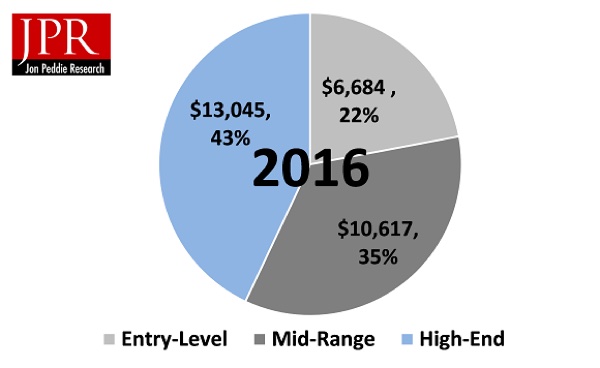It’s time for Apple to take Mac gaming more seriously. The global personal computer (PC) gaming hardware market has breached the $30 billion mark for the first time, according to Jon Peddie Research gamers buy (or customize) high-end (ie, pricey) systems, so a tricked-out iMac might appeal to such a group.
“Global consumers continue to embrace the PC platform for video games due to multiple factors,” says Ted Pollak, senior game industry analyst for JPR. “The desktop ergonomic is popular because the display distance offers increased detail when using HD and UHD monitors. Additionally there is superior control with mouse and keyboard control interfaces. This has been validated with eSports overwhelmingly being played on PCs.”
JPR has renamed the three segments of hardware it tracks to Entry-Level, Mid-Range, and High-End (from Mainstream, Performance, and Enthusiast).

Part of the phenomena JPR observes is that the ranks of PC gamers are growing in the Mid and High-End where average selling prices are high. Also, the average PC sale is increasingly motivated by the video game use model which is important to understand in a stagnant or declining overall PC market.
“As basic computing functions become more entrenched with mobile devices, the PC ultimately becomes a power user’s tool. Whether for gaming, photo and video editing, content creation, etc.,” says on JPR President Jon Peddie.
I’d love to see Apple make moves to improve gaming on our favorite computing platform. Some ways:
Offer an Apple joystick/gamepad — or at least the “hooks” so third parties could make ’em. This would require a macOS upgrade. This probably won’t happen, but but I know some users are tired of having to jump through a lot of software configuration hoops to play Mac games using a joystick/gamepad rather than the keyboard and mouse.
Really push Metal for macOS. Metal is a core graphics technology that gives apps near-direct access to the GPU [graphics processing unit]. This means faster and more efficient rendering performance across the system. Metal bypasses the OpenGL framework — which on macOS is slooow, dragging high-end Mac apps and games down in comparison to their Windows counterparts. Apple must ensure that Metal doesn’t lose its momentum.
Look into the The GameDock (based on a concept first developed by Mac/Life a few years ago), which was based on the success of the iPhone/iPad/iPod touch as a gaming platform: “Take this nifty little gaming platform and assign it double duty as both a handheld and a console system. The GameDock [pictured — in mock-up form] accommodates the iPhone and iPod touch and hooks directly to your TV and the Internet. Whether you download a game wirelessly via the handheld or wiredly via the GameDock, you pay just once for two versions of the same title.
“This is where things get interesting. When you download a game straight to your handheld, you can immediately begin playing the touch-controlled version of the game. And it’s glorious! And the next time you seat your handheld in the GameDock, the console immediately sucks down the full, expanded version of the game from the App Store, and stores it in its voluminous hard drive.
“So now you can play the console version of the very same game — with more features, more content, expanded controls, and, thanks to the GameDock’s integrated graphics processor, better visuals.
“And should you first download a game when your handheld is seated in the GameDock, the ‘mini’ version of the game shoots straight into your iPhone or touch, ready to play the next time you disengage from the console and hit the road.
“Of course, the GameDock scheme wouldn’t be quite so interesting if not for its seamless integration of content. For some game titles, the handheld version of the game exists as sort of an autonomous ‘mini game’ — its gameplay model runs independent of the console version’s. But for other titles, the handheld and console versions of the same game work together. Gameplay models obviously differ between the mobile and full versions, but each version hooks into the other in creative, novel, symbiotic ways. And through the power of syncing, your progress in level- and achievement-based games is saved and always propelled forward, regardless of which version you’re playing.”

However, what if Apple used the GameDock as a way to sell more Macs by offering gaming options that tie in with the iPhone, iPad and iPod touch as well as the Apple TV? This could turn the Mac into a Wii-like computer gaming system.
Instead of connecting to a TV, the GameDock would connect to a Mac (and perhaps be built into iMacs), allowing Apple computers to run the “bigger” versions of the “mini” games on the iPhone, iPad, and iPod touch that Mac|Life suggested. The GameDock would also allow multi-touch, accelerometer-equipped game controls to be used with the Mac games.

